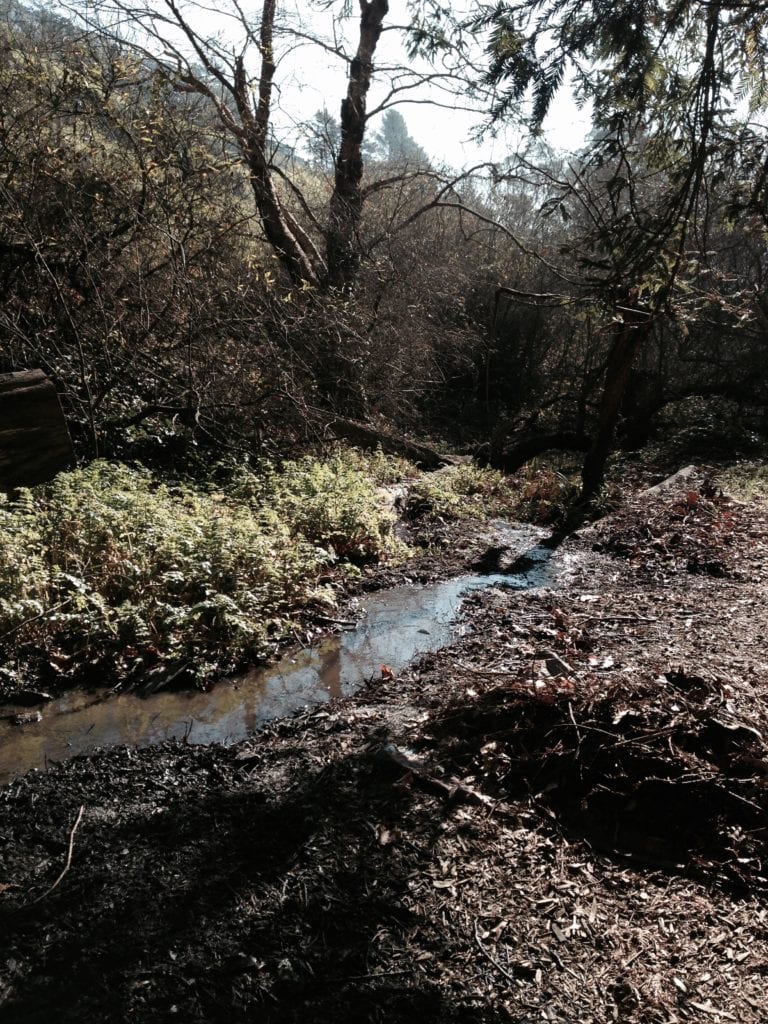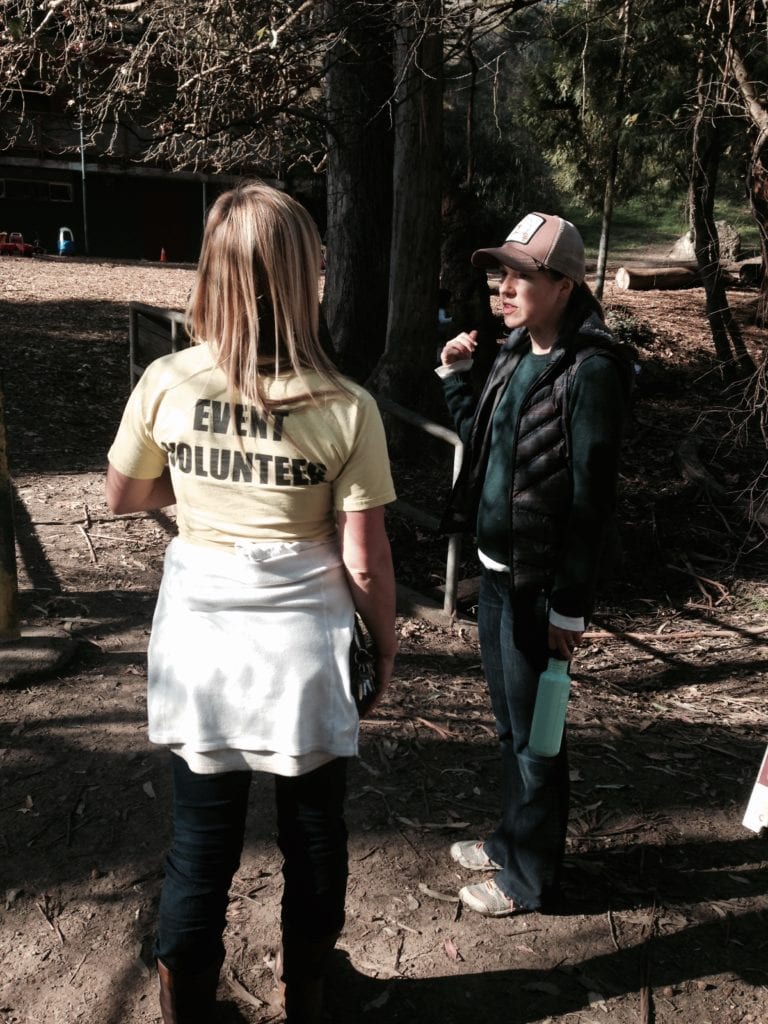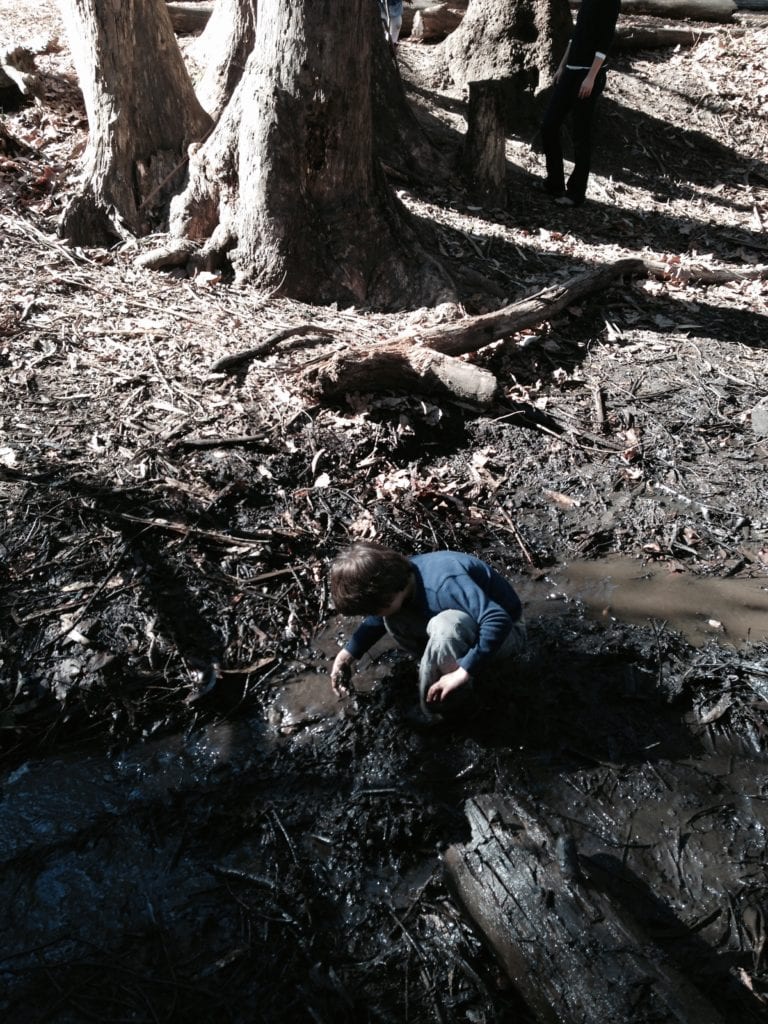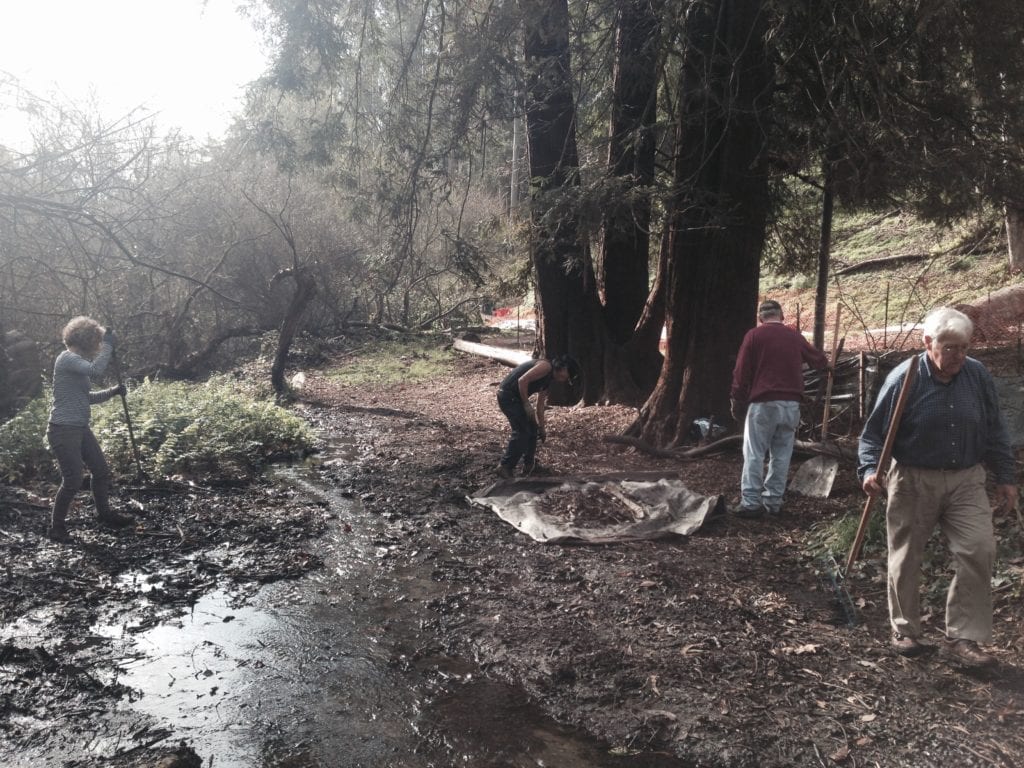
Story and photos by any
urray Schneider
In late January eight children from Brightworks School trooped past six volunteers from Friends of Glen Canyon Park.
In itself, this isn’t all that unusual.
Elementary school children on Glen Canyon field trips are often seen single-filing along Alms Road.
Close to February, though, what was unusual was that the five, six and seven-year olds who paralleled Islias Creek could hear it chuckle.

Rare December rains had caused San Francisco’s second longest above ground creek to run again, despite being obstructed by islands of eucalyptus duff.
The canyon volunteers were given the task of unclogging the blocked stream by Rec and Parks Natural Areas Program gardener, Jenny Sotelo. Each either carried tree limbs from the creek bed or raked leaves from the creek’s edge.
It was a while, then, before the retirees caught sight of the children who were accompanied by their teacher, Shawna Thompson.

Thompson approached a volunteer while her children remained in the company of a classroom aide.
“It really would be meaningful to us,” she told the volunteer, “if we could help with this work.”
Jenny Sotelo joined them.
The two women conferred for several minutes while the children played in the water and the NAP volunteers continued hauling detritus from the creek.

“I wanted the children to help,” explained Thompson, who earned a Bachelor of Science in Human Development and Family Sciences/Early Childhood Development from Oregon State University, “because they first encountered the stream barriers as an affront to ‘their space,’ and I wanted to transcend this by pushing them to see that they, too, could join in stewardship of their special place.”
A few feet away, a boy fingered earthworms. He began collecting them in a bottle. His classmates knitted, stitched and braided sticks and twigs that soon complemented the gum tree residue that hindered the creek’s flow.
Thompson didn’t allow this to continue.
“It’s a good time for them to learn it is not actually healthy to dump natural debris in the creek,” she said. “One of the children’s’ favorite tasks is ‘making soup’ in the stream.”
Thompson has taught for a dozen years, several at Brightworks. Before coming across town, she taught at Cow Hollow School, a project and inquiry-based preschool.
Over the last year she and her students have returned to Glen Canyon every other Wednesday where she can put to practice her belief that children must learn to love nature before they are asked to solve its problems, and the best way to love nature is to simply spend time in it.
“Learning authentically from an expert on the subject,” Thompson said, “is so much more meaningful than it would be if I were to tell them not to do it.”
Jenny Sotelo gathered the children about her. She told them that the creek used to be many times as big, that native-Americans once paddled along it to the bay. She engaged the kids in a dialogue about the living creatures’ dependency on the water, and told the children that instead of dumping sticks into the creek they could leave a pile next to it and this would benefit canyon birds.
The children set their minds to the task. They worked along side the adult volunteers for 30 minutes, gathering twigs and leaves, tenting them into tepees.
“The motivation for getting children into nature is simply because it’s really good for them on so many levels – physically, socially, emotionally,” said Thompson, who earned a Masters of Arts in teaching from Lewis & Clark College. “I have seen the children’s resiliency grow as a result of our hikes and getting dirty.”
About 40 minutes into their labors Thompson got some blow back. The children began complaining about the hard work and how long they’d been working.
But they didn’t stop.
“Perseverance came so naturally in that moment,” said “Thompson. “They learned not to put debris in the water, but they also learned they can have an impact on the place and its ecosystem.”
Teaching long enough to understand the role that serendipity plays in the educational process, Thompson continued:
“I have seen their relationships grow as a result of having shared experiences – the unexpected encounters such as this one in nature. Students have long, unstructured time to play, unscripted and unconstrained, with only nature’s loose pieces. It supports their creativity, their negotiation and their communication skills.”
The children continued working. When they became hungry, they shifted their food consumption to a tree stump for fear of littering sandwich bags in the stream.
Back to the creek, water lapped around their ankles and their hands muddied.
“The kids simply shrug off the dirt,” Thompson said. “That’s a good thing versus getting upset about it.”
Nolan, the boy totting up the earthworms, became even more focused, tallying the differences between them and the fatter one he’d gathered.
“All of our students are citizens of San Francisco, and they’ll become guardians and distributors of resources and knowledge,” said Thompson.
Distribution wouldn’t have long to wait. After the children returned to Brightworks, Thompson didn’t waste any time ‘checking for understanding.’
“When we returned to school the next day,” she said, contacted later by email, “three of the students created a podcast where they reported about the events. They recalled all of factual information Jenny Sotelo shared with them.”
“They also shared what I had taught them – that earthworms are so helpful because they eat the old leaves and ‘poop out’ the soil.”

On that day in January the kids could see the results of their labors. So could the Rec and Parks volunteers. The seniors and juniors had worked shoulder-to-shoulder on either side of the bridge that leads from Alms Road to Silver Tree Day Camp. The children worked on the north side, skipping and jumping across the narrow swath of water. Slower-of-foot, on the other side, the side where the bee tree stands, the old folk did their own heavy lifting. Their shovels and rakes laid strewn about them as they hefted eucalyptus limbs to the creek side and hauled tarps of leaves to a waiting truck.
Sun dimpled the now clear-as-glass stream’s surface. The creek rippled unimpeded, both edges of the creek liberated.
In no more than a blink-of-an-eye a bevy of sparrows and robins descended to the turf, scrabbling over the exposed dirt. Darting back and forth, they feasted on the exposed earth, pregnant now with insects and isopods.
Born in Oregon, raised in Alaska, Shawna Thompson hasn’t been coming to Glen Canyon as long as Jenny Sotelo and the neighborhood volunteers. But she’s no stranger, either.
“Glen Canyon and Islais Creek are very important to me,” she said. “I like seeing how many individuals and school groups access it on the days we are there, and I love that it has nature trails to hike, boulders to climb and wild edibles to pick, smell and remember, which is so important to kids.”
“I love the familiar routines that create an even more special connection to the place. For instance, we always pass the bee tree. We say hello to the dogs and their walkers. I am a very different teacher on our Wednesdays here – I’m more relaxed, alert in a different way. I slow down and notice new things about the children and especially about their relationships with each other.”
Shawna Thompson has created a workshop for educators and parents entitled “Awareness without Anxiety: Environmental Education for Young Children” and written a chapter in the book Nature Education with Young Children: Integrating Inquiry and Practice.
She’s employed by a school on the nineteen hundred block of Bryant Street, deep in the Mission District.
“The children play at a nearby park,” she summed up. “But that’s not the same as being creek side deep in the woods of Glen Canyon.”